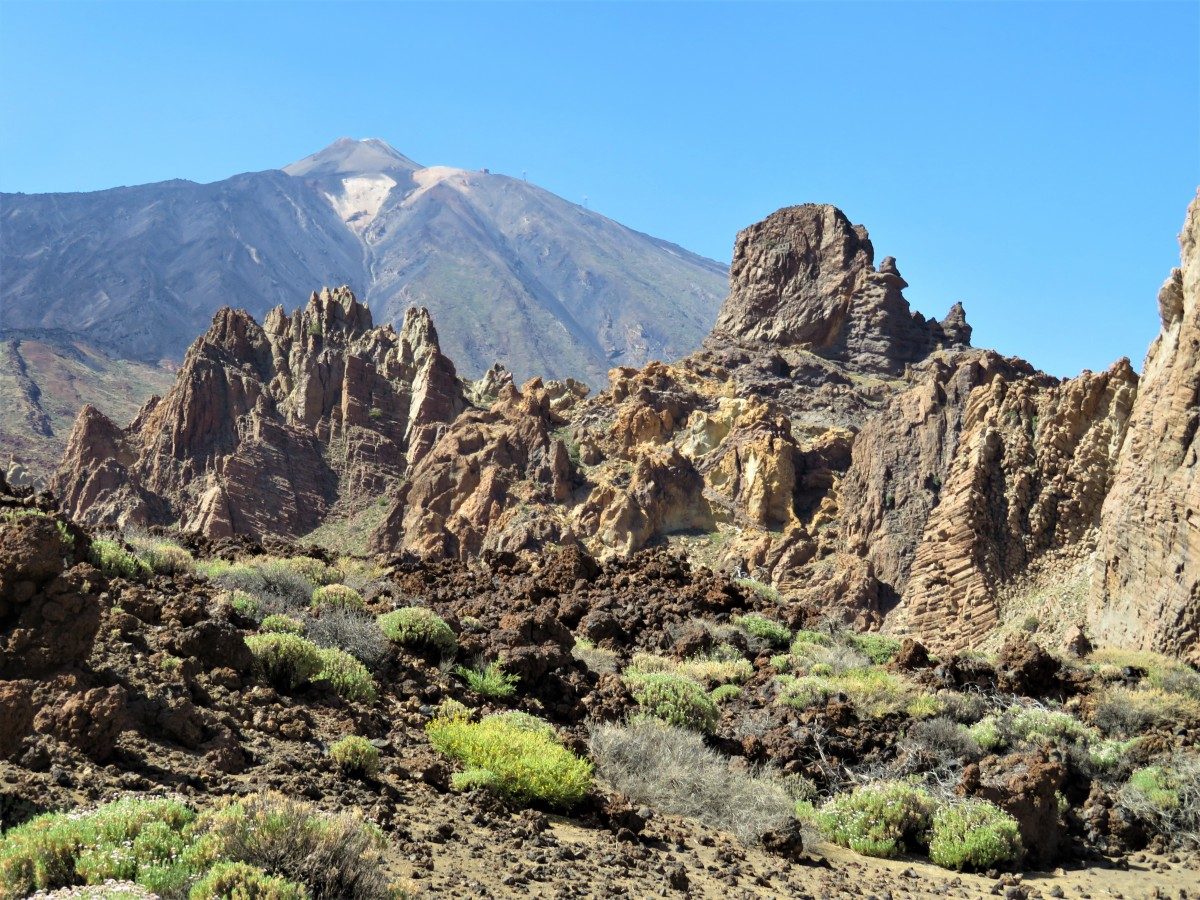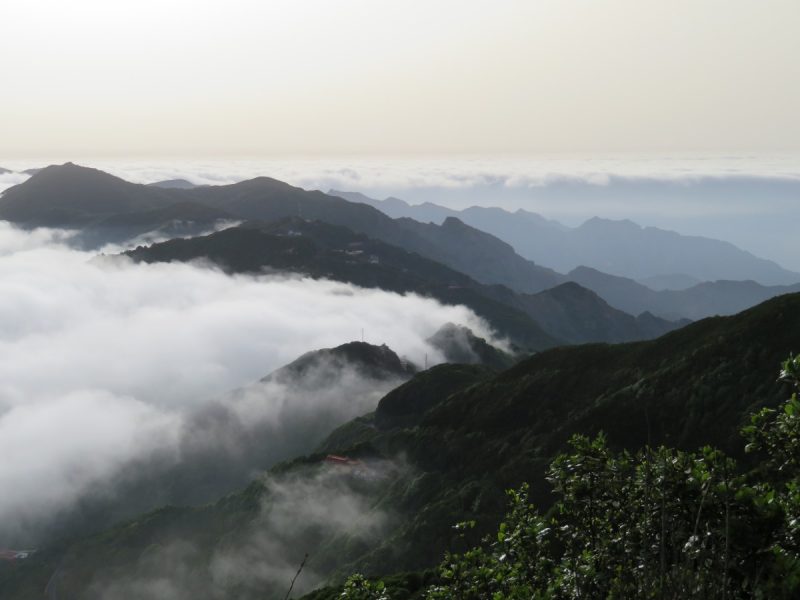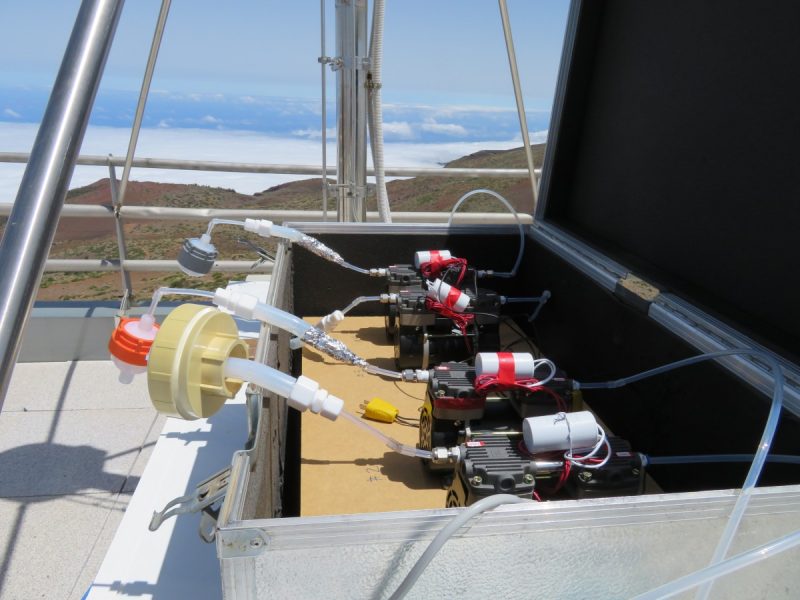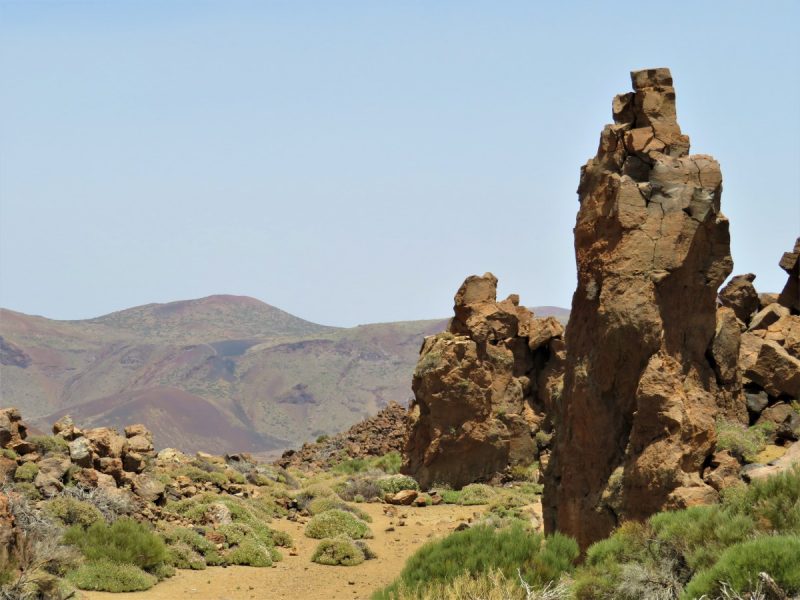
One sampling endpoint, with the Teide Volcano in the background
Researching Mercury and Saharan Dust Levels in the Canary Islands
Mercury – the famously liquid, famously toxic metal – is a contaminant with a worldwide scope. Of course, the beauty of studying global contaminants is that you get to see the globe. If you had asked me a year ago if I wanted to go to the Canary Islands, my answer would have been a deep sigh, a murmured ‘yes’, and a wistful gaze at the horizon. Imagine my delight on discovering there are legitimate scientific reasons to travel to spectacular tropical locales!
The Canaries, technically part of Spain, sit about 100 km off the coast of Morocco. They’re a small, isolated group of islands home to an important weather station – Izaña, where over a century’s worth of meteorological records have been collected. Izaña’s unique location allows direct study of air masses and dust storms travelling westward from the Sahara; it was our base of operations on the Island of Tenerife, and stands just a few kilometers from Teide, a gigantic volcano.
Tenerife is shockingly varied. The western shores of the island are open to the Atlantic, and thus predictably shrouded in cloud. The eastern shores, however, are continually bathed in dry Saharan air. If you get a bird’s eye view, the difference is striking.
If the winds are strong enough, clouds barrel over mountaintops and stream into valleys like pooling water. These conditions give rise to a place called ‘the enchanted forest’. As a scientist, I can say within a 95% confidence interval that it’s full of ghosts.
Of course, we weren’t there to learn about ghosts (still shopping around for funding). We were in Tenerife to learn about mercury, and we’re specifically interested in the role Saharan dust plays in its transport.
Previous research undertaken at Izaña revealed disruptions in the diurnal mercury cycle when dust storms roll in from Africa. Particulate-bound mercury sharply increases, as does elemental gaseous mercury, a potent neurotoxicant. This points to the dust itself as a possible source for both gaseous and particulate-bound mercury. Given that the Sahara is thought to be responsible for 50-55% of global dust emissions, Saharan dust may be an important mercury source for terrestrial and marine ecosystems worldwide.
How do we determine if Saharan dust is a mercury source? Well, first we collect the dust itself. The roof of Izaña is an ideal location to set up air filters and wait for dust storms to roll in. Guangyi, a recently minted PhD, had devised a simple but effective setup.
Here we have a collection of pumps, mercury traps, and filters. The system is designed to pull mercury both from the air itself, as well as collect dust on the filters. Izaña is ideal for collecting mercury that’s atmospherically sourced because Tenerife happens to be located within a stable temperature inversion. Warm, dry air cycling up from the equator traps cooler marine air beneath it; this process should also confine mercury released from the land and ocean to the marine layer. Izaña, at over 2300 m, is well inside the dry air layer, a region called the free troposphere. Mercury collected at this altitude is most likely sourced from the free troposphere itself, the stratosphere, or Saharan dust.
Collecting actual Saharan dust for analysis is all well and good, but we still need to characterize any potential alternate sources of aerosols and mercury. In this case, there’s one large potential alternate source – Teide volcano. At only a few kilometers from Izaña, our dust collection location, Teide looms well above us (3700 m) and could contaminate any material we analyze. In order to determine if the volcano contributes to mercury burdens, we set up a transect between Teide and Izaña then sampled soil (where dust is ultimately deposited), local plants (spartocytisus supranubius, an endemic but not protected species of broom), and rocks (parent material). Increasing mercury concentrations closer to the volcano would implicate Teide as a source. Of course, this sampling plan also provided us the opportunity to hike around Teide park for a few days, where the terrain was… impressive:
After a long summer’s day of trekking through hot alpine desert, we would return to sea level, where Santa Cruz de Tenerife waited for us. Every inch the tropical city, it was a welcome, relaxing reprieve from all the important science that needed to be conducted up at Izaña.
When the samples we collected are processed and we have a better idea of the mercury concentrations we’re looking at, another trip to the Canaries is probably in order – I can’t say I’m not looking forward to it. I’m willing to go to just about any beautiful island for scientific purposes, after all.
Project Supervisor: Dr. Feiyue Wang, CRC (Tier 1), Centre for Earth Observation Science (CEOS)









